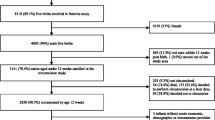Abstract
Neonatal male circumcision (NMC) is an uncommon procedure in Southern Africa, but is being scaled up in Zambia for long-term HIV prevention. We conducted a cross-sectional survey on NMC with a convenience sample of mothers of newborn boys at two public clinics in Lusaka. Following the survey, mothers received information on availability of NMC, and uptake of the service was tracked. Predictors of uptake were assessed using bivariate and multivariate logistic regression. Of the 1,249 eligible mothers approached, 1000 (80 %) agreed to participate. Although 97 % of surveyed mothers said they definitely or probably planned to have their newborn son circumcised, only 11 % of participants brought their newborn sons for NMC. Significant predictors of uptake in adjusted models included: Older maternal age (AOR 3.77, 95 % CI 1.48–9.63 for age 36 and above compared to mothers age 25 and below), having attended antenatal care at an NMC site (AOR 2.13, 95 % CI 1.32–3.44), older paternal age (AOR 4.36, 95 % CI 1.28–14.91 for age 26–35 compared to fathers age 25 and below), and the infant’s father being circumcised (AOR 2.21, 95 % CI 1.35–3.62). While acceptability studies in Southern Africa have suggested strong support for MC among parents for having their sons circumcised, this may not translate to high uptake of newly-introduced NMC services.



Similar content being viewed by others
References
Auvert B, Taljaard D, Lagarde E, Sobngwi-Tambekou J, Sitta R, Puren A. Randomized, controlled intervention trial of male circumcision for reduction of HIV infection risk: the ANRS 1265 trial. PloS Med. 2005;2:1112–222.
Bailey RC, Moses S, Parker CB, et al. Male circumcision for HIV prevention in young men in Kisumu, Kenya: a randomized controlled trial. Lancet. 2007;369:643–56.
Gray RH, Kigozi G, Serwadda D, et al. Male circumcision for HIV prevention in men in Rakai, Uganda: a randomized trial. Lancet. 2007;369:657–66.
Weiss HA, Quigley MA, Hayes RJ. Male circumcision and risk of HIV infection in sub-Saharan Africa: a systematic review and meta-analysis. Aids. 2000;14(15):2361–70.
WHO & UNAIDS Technical Consultation. Male circumcision for HIV prevention: Research implications for policy and programming. Reprod. Health Matters. 2007;15(29):11–14.
Binagwaho A, Pegurri E, Muita J, Bertozzi S. Male circumcision at different ages in Rwanda: a cost-effectiveness study. PLoS Med. 2009;7:e1000211. doi:10.1371/journal.pmed.1000211.
Weiss H, Larke N, Halperin D, Schenker I. Complications of circumcision in male neonates, infants, and children: a systematic review. BMC Urol. 2010;10:2. doi:10.1186/1471-2490-10-2.
WHO, UNAIDS, & JHPIEGO. Manual for male circumcision under local anaesthesia. Version 2.5b. Geneva: WHO; 2007.
Nagelkerke N, Moses S, de Vlas S, Bailey R. Modelling the public health impact of male circumcision for HIV prevention in high prevalence areas in Africa. BMC Infect Dis. 2007;7:16.
Central Statistical Office, Ministry of Health, Tropical Diseases Research Centre, University of Zambia, & Macro International Inc. Zambia Demographic and Health Survey 2007. Calverton: CSO and Macro International Inc.; 2009.
Zambian Ministry of Health. National male circumcision strategy and implementation plan 2010–2020. Zambia: Lusaka; 2009.
Lukobo M, Bailey R. Acceptability of male circumcision for prevention of HIV infection in Zambia. AIDS Care. 2007;19(4):471–7.
Westercamp N, Bailey R. Acceptability of male circumcision for prevention of HIV/AIDS in sub-Saharan Africa: a review. AIDS Behav. 2007;11:341–55.
Plank R, Makhema J, Kebaabetswe P, et al. Acceptability of infant male circumcision as part of HIV prevention and male reproductive health efforts in Gaborone, Botswana, and surrounding areas. AIDS Behav. 2010;14(5):1198–202.
Chi BH, Vwalika B, Killam WP, Wamalume C, Giganti MJ, Mbewe R, et al. Implementation of the Zambia electronic perinatal record system for comprehensive prenatal and delivery care. Int J Gynaecol Obstet. 2011;113(2):131–6.
Waters E, Stringer E, Mugisa B, Temba S, Bowa K, Linyama D. Acceptability of neonatal male circumcision in Lusaka, Zambia. AIDS Care. 2011; doi:10.1080/09540121.2011.587508.
Acknowledgments
The authors would like to acknowledge the research and lay counselor team (Melissa Jaffray, Ketty Lwabila, Lucy Milambo, Salome Temba, Juliet Mphundu, Valentine Phiri, Francis Chato, Prisca Mwaba) and the staff of Matero Reference Clinic and University Teaching Hospital who supported the study. We are most grateful to the study participants. This project was supported by the Centers for Disease Control and the Elizabeth Glazer Pediatric AIDS Foundation, PHE Tracking Number: ZM.07.0183 FY Activity No.: 12525.
Author information
Authors and Affiliations
Corresponding author
Rights and permissions
About this article
Cite this article
Waters, E., Li, M., Mugisa, B. et al. Acceptability and Uptake of Neonatal Male Circumcision in Lusaka, Zambia. AIDS Behav 17, 2114–2122 (2013). https://doi.org/10.1007/s10461-012-0297-8
Published:
Issue Date:
DOI: https://doi.org/10.1007/s10461-012-0297-8



